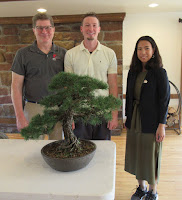The Akron Canton Bonsai Society was honored to host a workshop with visiting bonsai artist Adam Jones in October at Silver Springs Lodge in Stow, Ohio. Mr. Jones trained at the world famous Bonsai Village and Bonsai Museum in Omiya, Japan. He is the only westerner to own a successful bonsai nursery in Japan. The workshop was arranged and sponsored by the Japanese Consulate General in Detroit.
The workshop began with a discussion about our club's major project for this year, the 30 plus amur maples that we dug this past April. Mr. Jones offered plenty of good advice on care as well as a plan to train them into bonsai. Working with one of the maples that had grown wild this past summer, he discussed several important tasks, including selecting a front and visualizing an overall design for the tree. He also discussed how to select which branches to keep to develop branch structure. He also talked about pruning, building ratification. A video with some of his comments about developing the amur maples can be seen on our youtube channel.
Members participating in the workshop brought current bonsai "works in progress." These trees are in need of some good direction and coaching to bring them to the next level. There were several different species of trees, including maples, pine, juniper, spruce and yews. Additionally, we are also always looking to improve our own skills so that we might in the future create better bonsai.

 Working like a chess master playing several different games at once, Mr. Jones went from member to member giving detailed advice on design, pruning and care of the trees. He talked about some of the important considerations when beginning a tree project, such as studying the tree, selecting a front, the most advantageous planting angle, and other aspects of overall design. He was very specific and detailed in his instruction. For example, in discussing some pruning the overgrown branches on evergreen such as spruce
Working like a chess master playing several different games at once, Mr. Jones went from member to member giving detailed advice on design, pruning and care of the trees. He talked about some of the important considerations when beginning a tree project, such as studying the tree, selecting a front, the most advantageous planting angle, and other aspects of overall design. He was very specific and detailed in his instruction. For example, in discussing some pruning the overgrown branches on evergreen such as spruce or yews, he talked about which side branches to keep. Ideally left and right, eliminating those growing straight upward which will pull strong energy from the tree, and eliminating those growing downward from the branch which will become weaker. He also noted the importance of identifying the leaf buds, points that determine how far back you can clip. We have posted a video of parts of his discussion on pruning these still developing trees on our Youtube channel.
or yews, he talked about which side branches to keep. Ideally left and right, eliminating those growing straight upward which will pull strong energy from the tree, and eliminating those growing downward from the branch which will become weaker. He also noted the importance of identifying the leaf buds, points that determine how far back you can clip. We have posted a video of parts of his discussion on pruning these still developing trees on our Youtube channel. In addition to the workshop with ACBS, Adam's visit to Ohio included a demonstration at the Cleveland Botanical Gardens, as well as a lecture at the Franklin Conservatory in Columbus.
 |
| Stock Spruce |
The Akron Canton Bonsai Society would like to thank Adam Jones for his patient, thoughtful and practical help and direction with our tree projects. We would also like to sincerely thank the Japanese Consul General for selecting our club for this this terrific workshop. It was greatly appreciated.
 |
| Spruce after styling by Adam Jones |


























